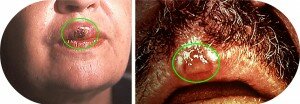Syphilis is a highly contagious infection caused by the syphilis bacteria or Treponema pallidum subspecies pallidum. It is the most common sexually transmitted disease and, luckily, also the most curable. It is estimated that around 5% of all adults are afflicted with the disease. Other subspecies of Treponema pallidum cause diseases such as pinta (a skin disease), yaws (an infection of the skin, joints, and bones), and bejel (endemic syphilis).
Identification and Genome
A spiral-shaped Gram-negative bacterium, Treponema pallidum is a parasite that burrows inside the body and causes a wide range of symptoms and conditions – from those that go away without treatment to those that are life-threatening. The syphilis bacteria were discovered during the fifteenth century and were isolated in 1912. Treponema pallidum can be identified using the Dieterle stain and through serology.
When diagnosing syphilis, tests such as rapid plasma reagin (RPR) test, nontreponemal VDRL or venereal disease research laboratory test, Treponema pallidum particle agglutination assay, and FTA-ABS or fluorescent treponemal antibody absorption test are useful.
The genome of Treponema pallidum was sequenced in July 1998. This was done because scientists wanted to study how it causes disease in humans and because it could not be cultured in a laboratory using traditional laboratory techniques. Through genome sequencing, biologists were able to better understand the structure, virulence, and reactions of Treponema pallidum to its environment.

Clinical Significance
The syphilis bacteria or Treponema pallidum subspecies pallidum is transmitted through sexual contact, prolonged kissing, and close bodily contact with an afflicted individual. The organism is a motile spirochaete that is flat and wavy, unlike other spirochaetes which are helical in shape.
This shape allows it to move swiftly through viscous substances such as mucus and semen. It enters its host’s blood and lymph systems through gaps in the columnar or squamous epithelial cells of skin and mucous membranes.
Current Research and Vaccine
For almost a century, penicillin has been the standard treatment for syphilis. In the 1990s, scientists developed an oral medication that was an alternative to the standard penicillin injection treatment. In the 2000s, scientists discovered that this new oral medication, Azithromycin, contained a mutation of Treponema pallidum. Because of this, they recommended that penicillin injections be used instead of Azithromycin for treating syphilis.
As of today, there is still no vaccine for syphilis. The syphilis bacteria have outer membranes that make any antibody ineffective against them and its inability to be cultured make efforts to study it particularly difficult.
The Four Syphilis Stages
The sexually transmitted disease syphilis is caused by Treponema pallidum, which is transmitted during sexual contact and sometimes from mother to baby during pregnancy and birth. The disease can manifest in one of four syphilis stages.
Primary Syphilis
Primary syphilis is normally acquired through direct sexual contact with a person who has infectious sores or lesions. Sometime between a few days and a few weeks after contact, the infected area will produce a sore called a chancre. Most of the time, the chancre will appear as a small, painless bump. The chancre is highly infectious and can last for weeks or months and may heal on its own.
Secondary Syphilis
Of the syphilis stages, this is the one where numerous symptoms start to appear. Symptoms of secondary syphilis include rough spots on the soles of the feet and the palms of the hands, white patches around the mouth, acne breakouts, genital warts, swollen lymph nodes, fatigue, headache, sore throat, and hair loss.
At this point, the chancre can be fading away but the infected area will start to form a rash that is itchy when touched. These symptoms can resolve without medication but, if left untreated, secondary syphilis will progress to latent and tertiary syphilis. Recurrences of secondary syphilis can also occur.
Latent Syphilis
Among the four syphilis stages, this is the only one where the disease is hidden. The latent stage starts when the symptoms from the secondary stage subside. This stage can last for two years to several decades. In latent syphilis, the patient has no symptoms but the disease is still present in the body and the patient is contagious.
Early latent syphilis is the period less than a year after secondary syphilis and late latent syphilis is the period more than a year after secondary syphilis. If left untreated, latent syphilis will progress to tertiary syphilis.
Tertiary Syphilis
This is the most frightening of syphilis stages. In tertiary syphilis, the symptoms aren’t noticeable and the infection can no longer be transmitted. However, unbeknownst to the disease-carrier, the bacterium remains within the body and is wreaking havoc inside.
Tertiary syphilis may occur years or decades after the initial infection and only then will the effects of the disease on vital organs be felt. Tertiary syphilis causes impotence, dementia, paralysis, blockages in heart vessels, blindness, fractures, and tumors.
The disease can cause internal damage to the eyes, brain, heart, nervous system, liver, and other organs. In some cases, the damage can be so severe as to be fatal.
Latest posts by admin (see all)
- What Can a Waist Trimmer Belt Do For You? Reviews of the Best Brands - April 7, 2015
- Choosing the Best Drops for Dry Eyes - April 4, 2015
- My Search Around the World for the Best Fingernail Clippers - April 3, 2015

{ 0 comments… add one }